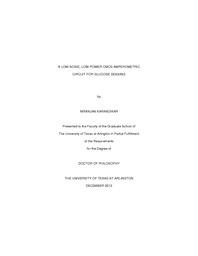
ATTENTION: The works hosted here are being migrated to a new repository that will consolidate resources, improve discoverability, and better show UTA's research impact on the global community. We will update authors as the migration progresses. Please see MavMatrix for more information.
Show simple item record
| dc.contributor.author | Karandikar, Niranjan | en_US |
| dc.date.accessioned | 2014-03-12T23:52:33Z | |
| dc.date.available | 2014-03-12T23:52:33Z | |
| dc.date.issued | 2014-03-12 | |
| dc.date.submitted | January 2013 | en_US |
| dc.identifier.other | DISS-12378 | en_US |
| dc.identifier.uri | http://hdl.handle.net/10106/24159 | |
| dc.description.abstract | Diabetes is disorder associated with an insufficiency of insulin secretion. Large number of people around the world suffers from this disorder which can result into damages to eyes, kidneys, nerves and even death. One of the most common methods to detect the diabetes is to monitor the levels of glucose is the blood stream. Other biological fluids like tear fluid can also be used to detect levels of glucose. With emergence of MEMS technology several biosensors are developed, less invasive or non-invasive, which can detect these glucose levels from blood or tear. Central idea behind the developments of these biosensors is to have a glucose monitoring system which is portable and/or implantable. In this work two novel circuit architectures for glucose sensing are presented. First architecture can be used to detect glucose levels from blood while second architecture, called wide dynamic range architecture, can be used to detect glucose levels from blood samples and from tear fluid. Existing circuit architectures requires two separate circuits one to control reaction potential, often called potentiostat, while other to readout reaction current. All of the architectures are based on operational amplifiers and do not fully appreciate the power of integrated circuits. These architectures are power hungry and noisy. Architectures presented in this work are less power hungry, generate less noise and are compact.Architecture proposed for glucose sensing from blood occupies 125µm*340µm of area while consuming 199µW of power and generating 312µVrms noise. Circuit is shown to measure glucose levels from 2.5mM to 10mM. Wide dynamic range architecture can be used to detect glucose levels either from blood or from tear fluid. Circuit occupies **** area while consuming 217.6µW of power and generating 444µVrms noise. Circuit is shown to detect glucose levels from 1 to 10mM. | en_US |
| dc.description.sponsorship | Jung, Sungyong | en_US |
| dc.language.iso | en | en_US |
| dc.publisher | Electrical Engineering | en_US |
| dc.title | A Low-noise, Low-power CMOS Amperometric Circuit For Glucose Sensing | en_US |
| dc.type | Ph.D. | en_US |
| dc.contributor.committeeChair | Jung, Sungyong | en_US |
| dc.degree.department | Electrical Engineering | en_US |
| dc.degree.discipline | Electrical Engineering | en_US |
| dc.degree.grantor | University of Texas at Arlington | en_US |
| dc.degree.level | doctoral | en_US |
| dc.degree.name | Ph.D. | en_US |
Files in this item
- Name:
- Karandikar_uta_2502D_12378.pdf
- Size:
- 1.534Mb
- Format:
- PDF
This item appears in the following Collection(s)
Show simple item record


